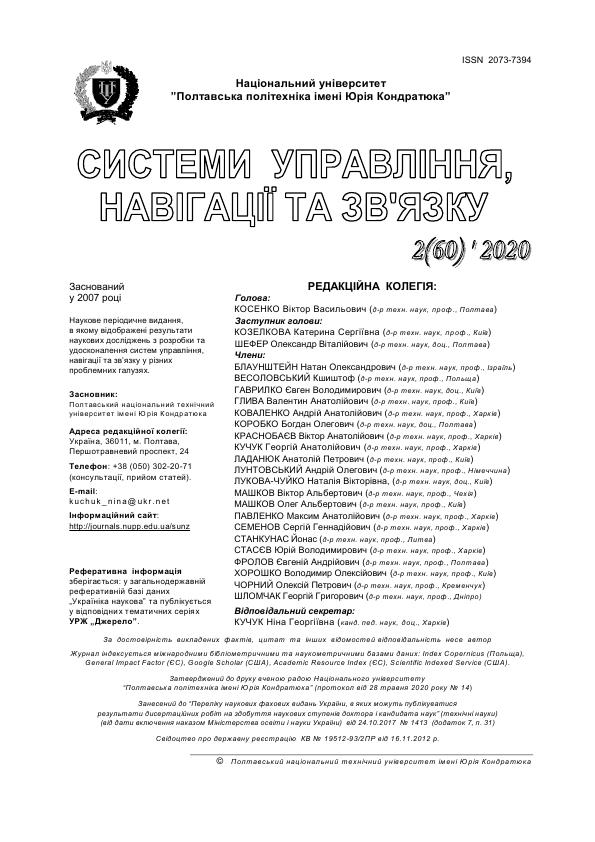MODEL OF CALCULATION OF TIME FOR RE-TRANSLATION OF RADIO-TECHNICAL UNIT WITH REGARD TO ORGANIZATION AND STAFF
DOI:
https://doi.org/10.26906/SUNZ.2020.2.148Keywords:
radio engineering unit, standby time calculation, time calculation model, relocationAbstract
The article is devoted to defining a model for calculating the readiness time of a particular radio unit for assigned positions. The current model of calculating the unit's readiness time does not take into account changes in the organizational and staff structure of the radio engineering unit and all possible time costs for the implementation of the preparation and execution of tasks. The existing methodology for calculating the time for relocation defines only the procedure for calculating the relocation of individual units and parts, but it cannot take into account all the features of training and relocation of radio units. The analysis of the stages of harmonization of the radio engineering unit showed the whole list of measures taken and what time indicators can be taken into account when calculating the ready time. These changes in the organizational and staff structure of the radio engineering unit make it possible to change and determine the model for calculating the time not only of the march, but in general the readiness of the radio engineering unit to complete the task for certain positions. Changes in the organizational and staff structure led to an increase in the number of units, which made it possible to carry out individual measures at the same time. The defined model of the procedure for calculating the time of readiness of the radio-technical unit to perform the task will provide an opportunity to get a unified approach to carrying out calculations and to take into account all possible time costs based on the experience of recent yearsDownloads
References
Історія радіотехнічних військ та основи фахової підготовки: Навчальний посібник / Г.В. Худов, Ю.І. Рафальський, Б.В. Бакуменко та ін. / За ред. Г.В. Худова. – Харків: ХНУ ПС, 2018. – 188 с.
Тактика радіотехнічних військ: Навчальний посібник / За ред. Г.В. Худова. – Харків: ХНУ ПС, 2018. – 240 с.
Air Power Australia [Електронний ресурс]. – Режим доступу: www.ausairpower.net.
Radartutorial.eu. Ingenieurbüro Christian Wolff [Електронний ресурс]. – Режим доступу: www radartutorial.eu.
Indian Radar Systems: [Електронний ресурс] // WORLD DEFENCE – 2008. - No 8. – Режим доступу: http://defenceanalyzist.blogspot.com/2011/08/indian-radarsystems.html.
LSTAR® Air Surveillance Radars [Електронний ресурс]. – Режим доступу: http://www.srcinc.com/whatwe-do/radar-and-sensors/lstar-air-surveillance-radar.html.
Петрушенко М. М. Створення єдиного поля радіолокаційного контролю повітряного простору держави / М.М. Петрушенко, В.Д. Карлов // Наука і техніка Повітряних Сил Збройних Сил України. – 2010. – No 1(3). – С. 111-116.
Кучук Г.А. Метод дослідження фрактального мережного трафіка / ГА Кучук // Системи обробки інформації. – Х.: ХУ ПС, 2005. – Вип. 5 (45). – С. 74-84.
Кучук Г.А. Метод мінімізації середньої затримки пакетів у віртуальних з’єднаннях мережі підтримки хмарного сервісу / Г.А. Кучук, А.А. Коваленко, Н.В. Лукова-Чуйко // Системи управління, навігації та зв’язку. – Полтава . ПНТУ, 2017. – Вип. 2(42). – С. 117-120.
Кучук Г. А. Метод синтезу інформаційної структури зв’язного фрагменту корпоративної мультисервісної мережі / Г. А. Кучук // Збірник наукових праць Харківського університету Повітряних сил. – 2013. – No 2(35). – С. 97-102.
Department of Defense Dictionary of Military and Ass. Terms. US NATO Military Terminology. – Chairman, 2006, 758 p.
Математичні моделі та методи аналізу надійності радіоелектронних, електротехнічних та програмних систем: монографія / Ю. Я. Бобало, Б. Ю. Волочій, О. Ю. Лозинський, Б. А. Мандзій, Л. Д. Озірковський, Д. В. Федасюк, С. В. Щербовських, В. С. Яковина. – Львів: Видавництво Львівської політехніки, 2013. – 300 с.




